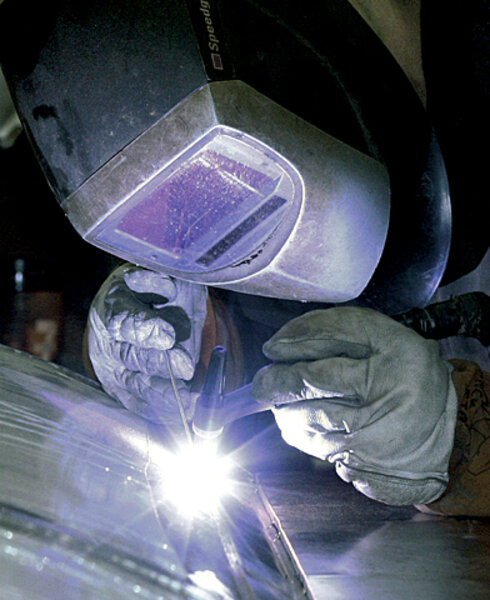The new classroom is a factory
Loading...
| Milwaukee
Former lab technician Annette Helmich is thrilled to have a new, in-demand skill and a full-time job to go with it – welding machinery.
While Ms. Helmich started learning her new craft by spending four weeks at a local community college, she says she polished her welding skills on the factory floor of her new employer, AGCO Corp. The Jackson, Minn., global manufacturer of agricultural machinery, which took over iconic names such as Massey Ferguson and Allis-Chalmers, is one of a number of manufacturers revisiting an old idea. Instead of relying on community colleges or private schools to get skilled workers, companies are again running their own training programs.
Two factors lie behind this return to in-house training: a quiet renaissance in some niches of America's Rust Belt and a shortage of highly skilled blue-collar workers. For some US manufacturers, business is booming and schools can't provide enough skilled workers. The shortfall provides a rare opportunity in this economy for good-paying jobs and the potential for secure employment.
"We tried that route" of recruiting at schools, says Dave Dehrkoop, AGCO's chief technical engineer for welding. Now, AGCO is developing factory-floor training programs at its facilities worldwide.
A similar story is unfolding at the Vermeer Corp. plant in Pella, Iowa, where busy production lines that utilize more than 300 welders can't always wait for the next batch of graduates from the nearest community college.
"We train our own welders in-house," says David Landon, manager of welding engineering at the company, which designs and manufactures equipment for the agricultural, construction, recycling, and surface-mining industries. "The schools cannot keep up with our demand, and that is if we took everybody. Other nearby manufacturers are also looking for welders, so we might get two or three out of a class and that's about it. And it's not enough."
One challenge: Fewer young people are learning a trade.
"Technical schools have fallen out of favor," says Carl Peters, director of technical training with Lincoln Electric Co., a Cleveland-based manufacturer of welding tools and components that markets its training methods nationally. "They were very, very busy in the '70s and then you got the generation that said, 'You know, if you're winners and if you're really smart, you should go on to college.... So we went through this deep dip in the '80s and '90s, and now we're starting to pay that price."
Despite the abundance of jobs and good pay, technical classes remain unfilled.
"There's a lot of old perceptions out there about it being undesirable work," says Karen White, executive director of the 360° Manufacturing and Applied Engineering Center of Excellence, a consortium that includes Bemidji State University and nine Minnesota community and technical colleges. It recently partnered with the Minnesota Precision Manufacturing Association to spread the word that production jobs are often clean, well paying, and highly computerized. "It's almost a 'Got Milk?' campaign for manufacturing," she says.
On-site training for blue-collar workers was once common. In the early and mid-1900s, long before it became part of AGCO, Allis-Chalmers offered a variety of apprenticeships and training programs targeting students as young as the ninth grade, as well as college graduates. Between 1918 and 1928, according to one corporate history, all but one executive in the shop had been trained at the plant.
In recent decades, companies have allowed schools to take over vocational training. But lately, the trend is for companies to get much more involved, serving on boards and partnering with tech schools to develop curriculum, while still letting schools lead recruitment.
"We have a [welding] school in the Houston area," says Tom Landon, manager of welding training and quality assurance for CB&I, a Texas-based manufacturer that designs and constructs storage tanks. "But we're not set up to go out and recruit young people."
Manufacturers see benefits to on-site programs. Training can be tailored to company-specific techniques and upgraded to include new technology. It also attracts job-seekers and boosts retention, says Dan Galiher, senior corporate welding engineer at Michigan-based Tower International, which makes car frames. "The ones we put through our training, we keep…. The ones that we hire in from college, no, they keep moving on."
Workers who want a high-paying career through a skilled trade should seek training in multiple places, such as at a tech school, in the military, at a university – and on the job, says Ernest Levert, a past president of the American Welding Society. "I share with the kids that you can decide to be hands-on as a technician or, if you get bored 'under the hood' all the time, increase your skills and become a robotics technician, an engineer, or a welding inspector."





